Borussia Mönchengladbach stormed to a 3-0 away win against Hoffenheim this weekend at the Rhein-Neckar-Arena. This left them one point away from the summit of the Bundesliga, whilst Hoffenheim slumped to their third defeat in the league. It was Mönchengladbach’s third away win in the league this season, and Hoffenheim have struggled this season following a ninth-place finish in the 2018/19 season. After six games they find themselves just two points ahead of the relegation zone. This tactical analysis looks at the tactics used by both Marco Rose and Alfred Schreuder as Mönchengladbach registered their fourth win of the season.
Lineups
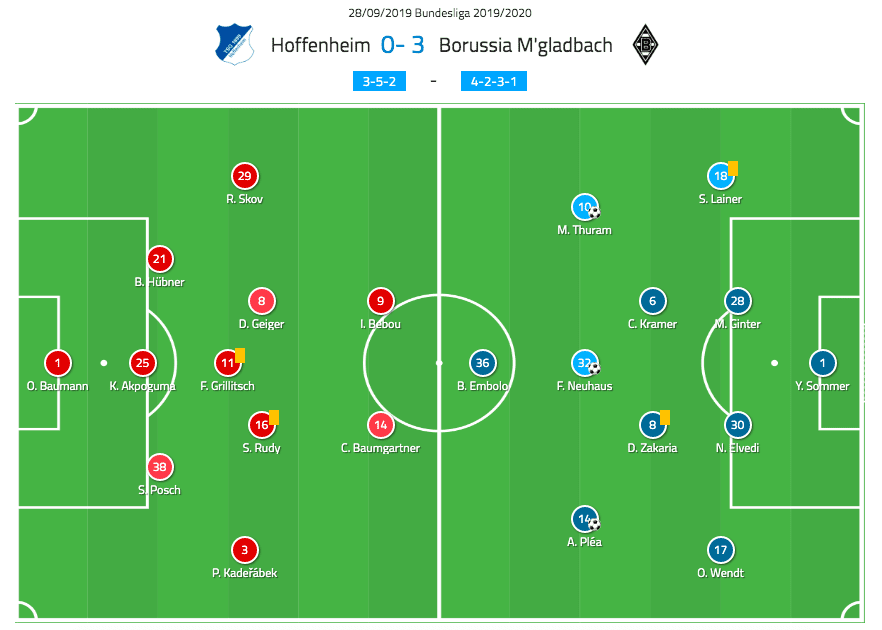
Hoffenheim fielded a 3-5-2, playing three at the back for the fourth time this season. They were without centre-forward Ishak Belfodil, so Christoph Baumgartner came into the starting XI. Kevin Vogt was also unavailable for this fixture, therefore Hoffenheim continued their trend of not playing the same backline in any two games this season. This time they used Stefan Posch, Kevin Akpoguma and Benjamin Hübner as a back three.
Mönchengladbach played a 4-2-3-1 for the first time since their 3-1 loss at home to RB Leipzig at the end of August. Marcus Thuram returned to the starting lineup, whilst Christoph Kramer came in for László Bénes in centre-midfield.
Hoffenheim’s poor finishing
Hoffenheim had 18 shots over the contest, and with an xG of 1.25 will count themselves unlucky not to have scored. Despite their high number of shots in this game, they managed only four shots on target. However, 13 of their 18 came from within the 18-yard box. Finishing has been an issue for Schreuder’s side so far this season, scoring a league-low of four goals so far, noticeably below their 7.44 xG.
Only 28.5% of their shots this season in all competitions have been on target. They were below this average with just 22.22% on target this game. They started the game well and looked the most dangerous of the two sides, to begin with. Their first three shots, all coming in the first 13 minutes, had a combined xG of 0.45.
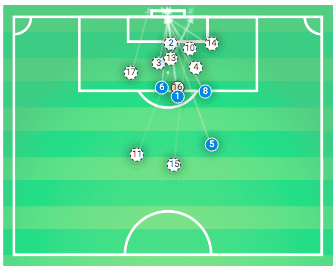
In the first half, they had seven shots with an average xG of 0.11 per shot. Baumgartner was very dangerous to begin with, and should have scored the rebound from Posch’s shot in the fifth minute. However, it was his movement for his second shot of the game that showed real intelligence from the forward. When the ball was played out to the right flank Baumgartner took up a position outside of right-back Stefan Lainer. Lainer was aware of Baumgartner’s positioning and couldn’t get too close to his centre-backs. As the cross was played in the forward made his run into the space to meet the cross and was unfortunate not to find the back of the net.
This was a tactic Hoffenheim repeated whenever they looked to cross from the right flank, clearly targetting Lainer’s body positioning as well as trying to find a hole in Mönchengladbach’s narrow defensive shape.
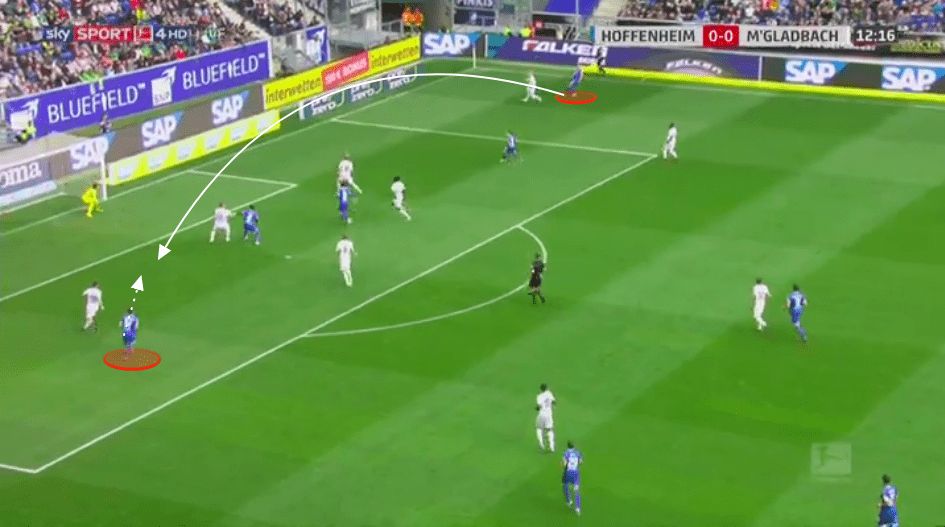
They paid for not being more clinical in the first half. In the second half, they had 11 shots but with an average of 0.04 xG per shot.
Thuram and Lainer’s dominance on the right flank
Schreuder’s decision to play a 3-5-2 with the attack-minded Robert Skov playing on the left flank against Thuram and Lainer certainly raised some eyebrows before kick-off.
It proved to be a decision that would cost Hoffenheim throughout the afternoon. Thirteen of Mönchengladbach’s positional attacks came from the right side as they concentrated the majority of their play down this side and gained plenty of joy in doing so.
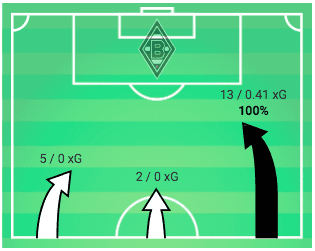
After an £8.1 million move from Guingamp this summer, Thuram has shown plenty of promise thus far. After scoring against Sandhausen in Mönchengladbach’s 1-0 DFB-Pokal win back in August, he has been an ever-present in the side since. However, he had to wait until last week’s 2-1 win against Fortuna Düsseldorf to notch again, scoring both of Mönchengladbach’s goals.
He was a thorn in the side of Hoffenheim’s defence throughout the game this weekend. Thuram exploited the pace he was afforded to run into. His pace, as the ball was played behind the Hoffenheim defence by Lainer, forced Hoffenheim’s defence to move out of shape in order to counter this threat. As Hubner missed the interception, it forced Akpoguma to move across in a bid to intercept Thuram. However, this led to space in the centre of Hoffenheim’s 18-yard-box for Neuhaus to infiltrate.
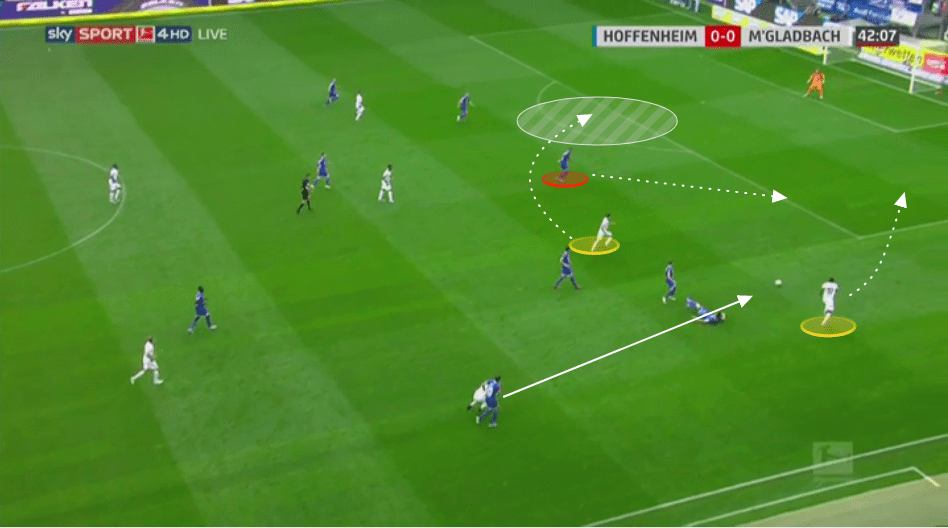
Thuram showed incredible poise for a player at such a tender age to hesitate on his pass into the six-yard box. As Neuhaus positioned himself in a dangerous position near the penalty spot, the obvious pass was to play it into his path and Posch recognized this by dropping into this area. Thuram’s decision to delay on the pass allowed Alassane Pléa to sneak into the space vacated by Posch and score.
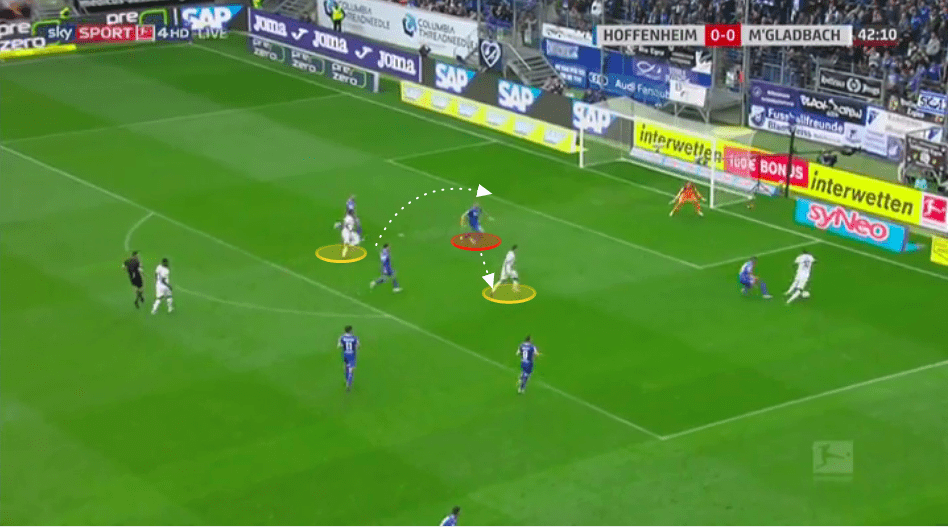
Lainer was able to capitalize on the lack of coverage by Hoffenheim on his flank too. Throughout the game, he was able to cross at will and completed his highest amount of crosses this season, with six. He was accurate with 67% of his nine attempted crosses and was the only player on the Mönchengladbach side to register a completed cross all afternoon. The fact that 63% of Mönchengladbach’s attempted crosses came from Lainer and Thuram’s side shows how much of a problem their right flank was for Hoffenheim all afternoon.
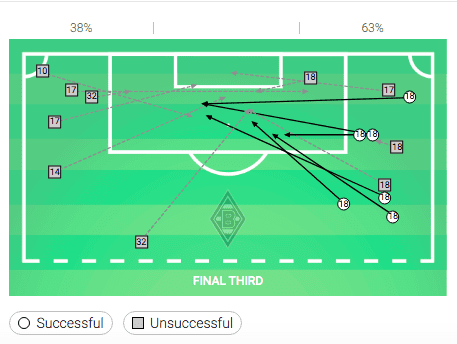
Lainer worked tirelessly throughout the afternoon, as expected, in order to support Thuram. It was the combination of Lainer and Thuram that led to Mönchengladbach’s second goal of the game. As Thuram travelled in possession, Lainer overlapped creating space for Thuram to drive with the ball as Hübner was unable to press the ball-carrier until Skov tracked back far enough to cover Lainer.
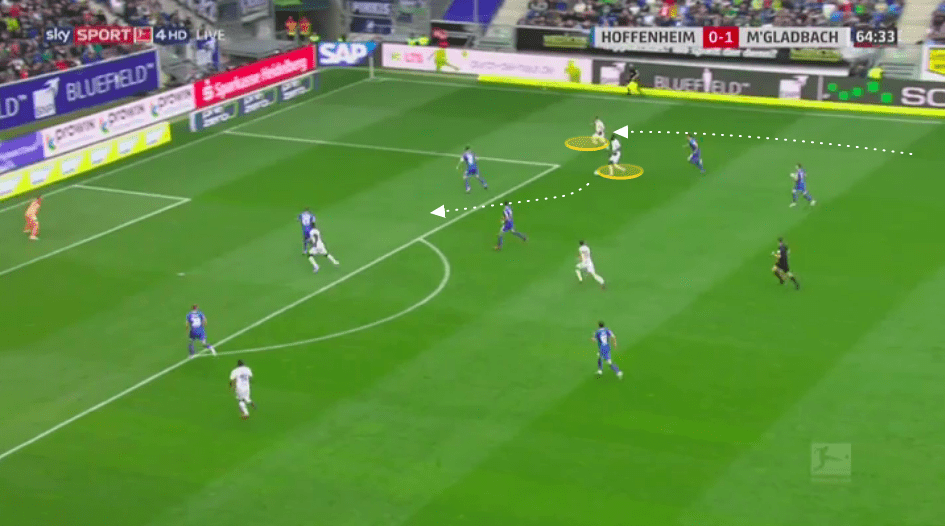
Hoffenheim’s defensive issues
At the beginning of the second half, Mönchengladbach changed to a 4-3-1-2 for the first 21 minutes before reverting back to a 4-2-3-1.
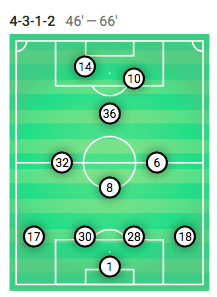
They were more direct in their approach with 17% of their passes being long balls, almost double their average for the game of 9.71%. This was likely down to them witnessing a Hoffenheim defence that were unsure of their defensive shape and roles throughout the first half. The back three struggled to maintain a tight defensive shape between them, whilst Skov struggled with protecting Hübner as mentioned before.
Breel Embolo sat behind the front two and was able to drop deeper to work as a progressive ball-carrier. He also made late surging runs into the Hoffenheim box. Had he converted from close range in the 62nd minute, the scoreline would have been even worse for the home side.
The chance came from Hoffenheim’s defensive issues as Skov didn’t track Thuram, whilst Hübner was brought out of position by Neuhaus dropping deep. Thuram was able to run behind once again, pulling Akpoguma over in a similar fashion to the first goal. Embolo was able to glide into the back post unmarked with Hoffenheim’s defence being pulled all over the width of the pitch.
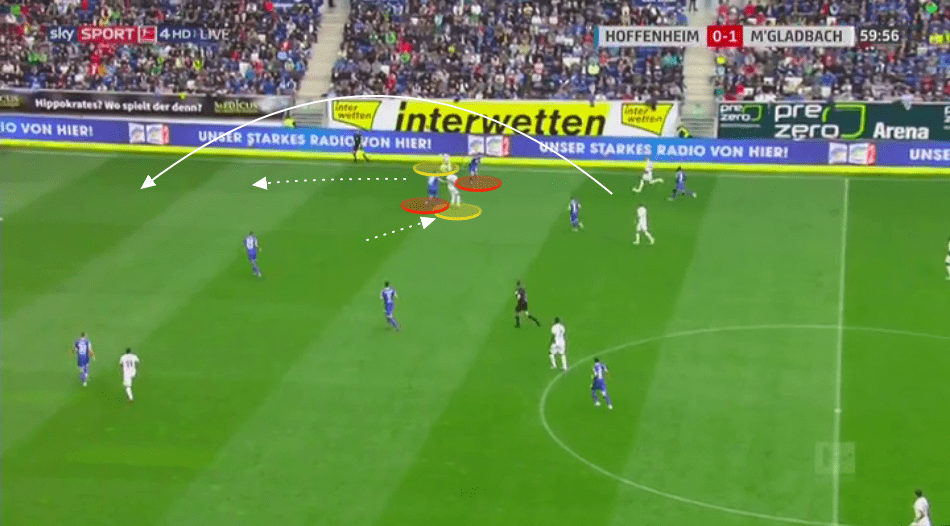
This was the first time this back three had played together this season and it showed as they struggled to maintain a compact shape and prevent balls being played between them. Akpoguma was frequently caught too deep, allowing plenty of space behind both Hübner and Posch for Mönchengladbach to play into. The analysis below shows a chance that is close to the Hoffenheim goal where allowing this amount of space for Neuhaus to run into is an incredibly risky decision.
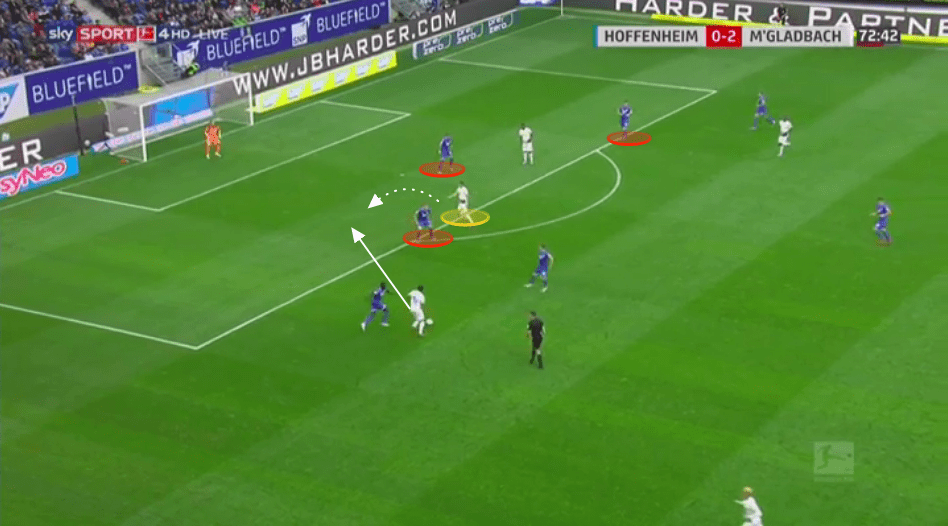
Conclusion
Hoffenheim had chances to score and were unlucky not to do so, which has been a recurring theme in games this season. Yet they didn’t do enough to win, and Alfred Schreuder’s makeshift back three struggled to deal with the fluidity and pace of Mönchengladbach’s forward play.
Marco Rose will be pleased with how Mönchengladbach responded in the second half to take the game away from Hoffenheim whilst their solid defensive work, particularly in the second half, kept Hoffenheim’s attempts on goal to relatively speculative efforts.

If you love tactical analysis, then you’ll love the digital magazines from totalfootballanalysis.com – a guaranteed 100+ pages of pure tactical analysis covering topics from the Premier League, Serie A, La Liga, Bundesliga and many, many more. Buy your copy of the August issue for just ₤4.99 here





Comments